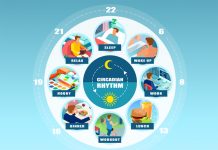The adolescent years are a time of change and transition towards adulthood. For many, they can bring stress and anxiety that can affect mental health and well-being. This month, we explored the link between mind and movement, and how community pharmacies can help teens stay healthy and active.
Adolescence is a “unique and formative time” during which “physical, emotional and social changes can make adolescents vulnerable to mental health concerns”, according to the World Health Organisation.1
“Globally, it’s estimated that 14 per cent of those aged between 10 and 19 years experience mental health conditions, yet these remain largely unrecognised and untreated,” the WHO said.
In 2019, according to the US Centres for Disease Control and Prevention (CDC), “more than one in three high school students [in the US] had experienced persistent feelings of sadness or hopelessness, a 40 per cent increase since 2009”.2
The Australian Institute of Health and Welfare describes mental health as “a state of wellbeing in which an individual realises their own abilities, can cope with the normal stresses of life, can work productively, and can contribute to their community”.
“Poor mental health can impact the potential of young people to live fulfilling and productive lives,” the organisation said.3
It’s important to recognise mental health issues in adolescents and to realise that these may not be simply a phase or just a case of ‘feeling blue’. As the CDC says, mental health issues “can impact many areas of a teen’s life”.
These areas, it adds, include school performance, decision making, health and behavioural risks such as drug use, experiencing violence, and “higher risks of sexual behaviours that can lead to STDs and unintended pregnancy”.
The Australian parenting website, raisingchildren.net.au, cites the following as some of the warning signs that may indicate an adolescent needs help with their mental health:4
- Seeming down, feeling things are hopeless, being tearful or lacking motivation.
- Having trouble coping with everyday activities.
- Showing sudden changes in behaviour, often for no obvious reason.
- Having trouble eating or sleeping.
- Doing less well at school, or suddenly refusing to go to school, TAFE, or work.
- Avoiding friends or social contact.
- Complaining of physical pain – for example, a headache, stomachache or backache.
- Being aggressive or antisocial – for example, missing school, getting into trouble with the police, fighting or stealing.
- Being very anxious about weight or physical appearance, losing weight, or failing to gain weight as they grow.
To help promote mental health and well-being among adolescents, experts recommend strategies that include showing interest in an adolescent’s life, family connection and support, and encouraging communication – getting teens to talk about their feelings.
Strategies that can be promoted within a community pharmacy may include physical fitness through healthy and safe regular exercise, healthy eating habits, regular sleep patterns, balancing screen time and the use of technology (particularly social media), and encouraging the avoidance of alcohol and drug use.[1]
Key resources when working in the area of adolescent mental health:
Keep moving
Regular exercise is essential during childhood and the teenage years as it helps to “lay the foundations for a healthy and active adult life”, says accredited exercise physiologist Tim Douge.
“It will help the musculoskeletal system develop in line with growth spurts and changes in body shape,” he said.
“It will stimulate positive changes to the nervous system, which can help coordination, as well as improve cognitive outcomes. It can help to regulate emotions and mood, as well as provide an avenue for social interactions in a time many consider to be an ‘awkward phase’.
“Adolescence can be a time of heightened psychological distress, of which there’s a high incidence caused by body image disorders. Physical activity has been shown to reduce the prevalence and significance of body image disorders, with body image satisfaction increasing proportionally to the level of physical activity.”
Adding to this, the federal Department of Health and Aged Care website5 lists other advantages of regular activity, including “many social, emotional, intellectual and health benefits”.
These benefits, according to the site, include:
- A chance to have fun with friends and family.
- Reduced antisocial behaviour.
- Stronger cooperation and teamwork skills.
- Better self-esteem and confidence.
- Lower anxiety and stress.
- Better concentration.
- Healthy growth and development.
- Improved fitness, including coordination and movement skills.
- Lower risk of disease.
- Lower risk of unhealthy weight gain.
“All children and young people should get the right mix of physical activity, [rest] and sleep in each 24-hour period,” the department states.
Mr Douge claims 20 per cent of adolescents are known to experience symptoms of anxiety, and 50 per cent to experience symptoms of depression.
“Alongside sleep, physical activity is one of the most significant factors to affect anxiety and depression [in this age group],” he said.
“Moderate-to-vigorous exercise not only has a preventative factor against mental health issues, but it can also improve the symptoms in those suffering from anxiety and depression. While all physical activity can be beneficial, higher-intensity exercise and physical activity in team sports are most effective.”
Teens, he advises, should undertake “a minimum of 60 minutes of physical activity every day, with moderate to vigorous activity at least three times a week”, while getting regular sleep, which is “incredibly important”.
The federal Department of Health and Aged Care5 recommends adolescents undertake “at least 60 minutes” of moderate to vigorous physical activity each day”.
These activities can include:
- Running.
- Climbing.
- Playing on the playground.
- Sports: football, netball, basketball, rugby, rugby league.
- Swimming.
- Dancing.
- Bike/scooter riding.
- Walking to school.
- Walking the dog.
- Going to the park.
- Helping around the house.
For more information, visit: health.gov.au/resources/publications/24-hour-movement-guidelines-children-and-young-people-5-to-17-years-brochure.
“Teens are incredibly resilient,” Mr Douge said, addressing the potential safety precautions around beginning a regular program of exercise.
“Some considerations might be needed if rapid growth spurts have been experienced, which can cause joint pain, [but] this doesn’t mean physical activity should be avoided. Teens should be encouraged to enjoy exercise that feels comfortable and fun.”
While daily physical activity is important, it’s also vital that children and adolescents get enough sleep. The federal Department of Health and Aged Care5 recommends that each night:
- Children aged five to 13 years get nine to 11 hours of uninterrupted sleep.
- Young people aged 14 to 17 years get eight to 10 hours of uninterrupted sleep.
To ensure quality sleep, it’s recommended children and adolescents have consistent sleep and wake-up times. They should avoid screen time at least one hour before bed and keep screens and gadgets out of the bedroom.
How community pharmacy can help
Mr Douge says community pharmacists should have general information available related to exercise guidelines for teens or parents to access.
“This could be in paper form in the pharmacy or on a website or e-newsletter,” he said. “If pharmacists have a good relationship with their customers, they may be able to have more direct conversations to ensure teens are staying active.
“For example, during high school exam periods, it would be beneficial to remind parents and teens that physical activity is going to help their stress, mood, memory and cognition.”
Mr Douge continued: “Pharmacy staff should have a good database of their local exercise physiologists to refer parents and teens to, should they need tailored exercise advice. If they don’t, they can easily search the Exercise & Sports Science Australia database at essa.org.au
“An accredited exercise physiologist can provide detailed assessments and advice for which exercise or activity would be most suitable or beneficial, and can point teenagers in the right direction to achieve that.”
References
- who.int/news-room/fact-sheets/detail/adolescent-mental-health
- cdc.gov/healthyyouth/mental-health/index.htm
- aihw.gov.au/reports/children-youth/mental-illness
- raisingchildren.net.au/pre-teens/mental-health-physical-health/about-mental-health/teen-mental-health
- health.gov.au/topics/physical-activity-and-exercise/physical-activity-and-exercise-guidelines-for-all-australians/for-children-and-young-people-5-to-17-years
This feature was originally published in the February issue of Retail Pharmacy Assistants e-magazine.






